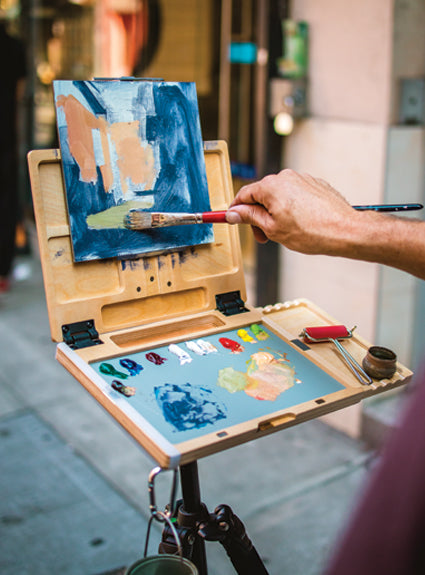LOCATION: Los Angeles, CA
CAREER: Filmmaker & Artist
EDUCATION: Studied privately with George Cherepov
WHAT IS A LITTLE KNOWN FACT YOU WOULD LIKE TO SHARE?
I nearly gave up painting because well meaning instructors told me to cover the canvas as quickly as possible. Every time I painted in such a manner, I ended up getting lost very quickly, therefore I don’t find this to be a very good idea. When painting from life, I believe you should get something correct on the canvas as quickly as possible. The right shape, the right color and the right edge. From there you can make your judgments of other shapes and colors far more accurately because you know that there is at least one thing right on the canvas. This is a technique employed by several great painters today and was certainly how Edward Redfield and some of the other Pennsylvania Impressionists created their work.

YOU PAINT IN A STYLE COINED AS THE PENNSYLVANIA IMPRESSIONIST MOVEMENT THAT EMPHASIZES COLOR AND LIGHT EN PLEIN AIR. WHEN STARTING A PAINTING, WHAT IS YOUR CREATIVE PROCESS?
First off, I have to be moved by what I am seeing. The first thing I do is try to translate what I am seeing into an emotion that I can clearly define...
Is the image cozy?
Is the image vast?
Is the image lively?
Is the image subdued?
Once I can clearly define not only what I am seeing but the emotions that arise in me, I can begin to design the composition to help support that main theme. The colors, values and edges should all support the main theme of the painting. Good landscape painting has to be more than just rendering what you are seeing. You must find a way to incorporate your own sense of individual excitement about what’s going on before you and what it is doing to your senses.

OF ALL THE LOCATIONS YOU HAVE PAINTED, IS THERE A SPOT THAT IS MOST MEMORABLE TO YOU?
The creek at Phillip’s Mill in New Hope, Pennsylvania. Although I live in Los Angeles, I have visited that particular location many times. It is where many of the great Pennsylvania Impressionist paintings were done. Every time I go back I feel as if I’m visiting an old friend. Those feelings of nostalgia always get into my paintings of that particular spot.
You recently wrote a book that is now available called “Impressionist Painting for the Landscape: Secrets for Successful Oil Painting.” In it you discuss the techniques you have mastered to create the visual effects that your paintings are known for. What are one or two tips you have for someone that paints or wants to paint in the Impressionist style?
The most important thing that one has to do in order to paint impressionistically is to not see objects as objects, but merely as abstract shapes of color. If one tries to paint a tree with all of its intricacies, you can really get lost. It is better to look at the tree and break it down into its various shapes, tones and colors, see them as paint, then simply put it down. The key is to trust what you are seeing and to also trust your original intentions. When creating a painting it is sometimes difficult to trust that what you’re putting down is accurate both visually and emotionally because colors and shapes are all relative. As you continue putting down the things you see (or feel) accurately, the painting should come together, especially if it is built on a very sound compositional idea. I find that much of painting is all about trust.

LETS TALK ABOUT ART MATERIALS AND TOOLS FOR A MOMENT. WHAT ARE YOUR "GO TO" MATERIALS AND TOOLS?
My favorite New Wave handcrafted wood palette of choice is the large Grand View palette. There’s nothing better than mixing paint on top of that beautiful, warm, light brown surface. It makes you feel like a great painter even if you’re having a rotten day. I also enjoy using the Grey Pad rectangular paper palette quite often.
I use a variety of brushes and painting knives. All of them are bristle brushes. On occasion I use a sable for passages that are soft, but as a general rule I use bristle brushes because they hold a lot of paint. Much of painting is about comparisons and relationships. If one area has lots of choppy strokes, it’s always a good idea to counter balance it with a softer or flatter area. Painting knives are great for that. The sharpest edges of all are done with a knife. These varieties create wonderful dynamic differences in your paintings. The brushes I use are by Rosemary and Co. Brushes. I think they’re the best brushes on the market. I also use Michael Harding Oil Paint. It’s highly concentrated and the colors are absolutely true. It’s generally a good idea to use the same tools, especially when working outdoors so that you know how everything will behave. Painting outdoors is difficult enough without trying to figure out how your tools work, especially when there’s limited time because of the constantly changing light.
In terms of specific tools, I use flat bristle brushes for the more broadly painted passages and eggberts to create the more delicate and softer areas. The swords are great to create both big sweeping strokes and fine details at the same time because of the way they come to a chiseled point. The daggers are wonderful to create strokes with lots of energy. They’re wonderful for rushing water, flowers, sharp edged stones, foliage, etc. I use riggers to create the finest of lines.

WHERE CAN SOMEONE FIND OUT MORE ABOUT UPCOMING WORKSHOPS OR DEMONSTRATIONS WITH YOU?
On my website at ggallo.com or on my Facebook page. I haven’t been doing any workshops as of late, but I plan on doing some next year.

-George Gallo
www.ggallo.com









